Abstract
This study explores the perspectives of Indian library professionals on the use of artificial intelligence (AI) in libraries. It aims to understand their knowledge, awareness, and views on AI and its challenges and opportunities. The research adopts a quantitative approach, using a closed-ended survey to collect data from 386 library professionals in academic institutions across India. The survey covers various aspects, including socio-demographic information, AI knowledge, perspectives on AI in libraries, ethical considerations, and adopting AI tools and services. The findings indicate that Indian library professionals are generally aware of AI and its potential benefits in libraries. They believe that AI can enhance library activities, improve accessibility, and support decision-making. However, there are concerns about AI replacing human intelligence within libraries. Factors such as user privacy, funding, staff expertise, and alignment with institutional goals are essential when implementing AI applications. Ethical considerations, including bias and discrimination, intellectual freedom, and transparency, are also significant concerns. AI tools like smart shelving and optical character recognition are among the technologies already adopted in Indian libraries.
1 Introduction
Integrating artificial intelligence (AI) into library services has grown increasingly popular, potentially transforming the sector by significantly enhancing routine library operations and services (Cox, 2022). Typical library functions entail recurrent tasks performed by library professionals ranging from user services to technical undertakings like development and management. Such tasks, although necessary, often prove time consuming, detracting from professional growth and library enhancement opportunities (Johnson, 2018). Many libraries have embraced automation through information technology, but these systems require considerable human interaction and involvement. For instance, in organising library information – such as classification and cataloguing – library professionals must manually ascertain a collection’s metadata before system entry. This process demands significant time expenditure (Al-Aamri & Osman, 2022).
Nevertheless, recent trends have shown an increasing reliance on AI in libraries to assist library professionals in their duties. This trend led to the emergence of smart, or “intelligent,” libraries, accelerated by the COVID-19 pandemic (Chen, Zhou, & Feng, 2021). The infrastructure of a smart library comprises elements such as a data centre, AI-powered robots, wide visual screens, and dual identification methods for enhanced privacy protection (Gul & Bano, 2019). The demand for smart library applications is growing, with popular features encompassing facial recognition, radio frequency identification (RFID)-based applications, indoor navigation, seat reservation, self-service printing/photocopying, and smart lockers (Bi et al., 2022).
However, despite the increasing adoption of AI in libraries and the opportunities it presents, the trend is still in its nascent stages. A few libraries have so far implemented AI due to various considerations, such as the availability of facilities, budgetary constraints, human resources, and policy-related issues, all of which determine a library’s capacity to incorporate AI (Arlitsch & Newell, 2017). Thus, this study aims to comprehend library professionals’ perspectives on AI applications in Indian libraries, hoping to elucidate their views on AI’s potential opportunities and challenges (Hussain, 2023).
1.1 Objectives of Study
To identify the socio-demographic characteristics of Indian library professionals.
To evaluate the perspective of Indian library professionals on AI usage in libraries.
To analyse discrepancies in the perceived knowledge and proficiencies concerning AI technologies among Indian library professionals.
To identify the potential usage of AI in the libraries.
To measure the perception of Indian library professionals regarding the impact of AI technologies on library resources and services.
To identify the AI tools and services currently used within Indian libraries.
To comprehend the ethical considerations among library professionals on AI utilisation.
2 Literature Review
Exploring AI within libraries is a field of study that has been around for a while. A systematic review conducted on Google Scholar in 2023 about “artificial intelligence,” “smart libraries,” and “library” as crucial phrases elucidate this fact by presenting an array of conceptual papers, empirical research studies, and literature reviews (Harisanty, Anna, Putri, Firdaus, & Noor Azizi, 2023). As Arlitsch and Newell (2017) observe, the expanding capabilities of computational processes, combined with the growth of big data and advancements in machine learning techniques, have spurred progress in AI. This progression has started to transform numerous sectors, not excluding libraries.
Harisanty, Anna, Putri, Firdaus, and Noor Azizi (2022) and Harisanty et al. (2023) propose that libraries can smoothly integrate AI technologies to enhance administrative, technical, and informational functions. Libraries are already incorporating AI into various services, such as technical support and reference services, thereby improving user access to information (Al-Aamri & Osman, 2022). As AI advances, users increasingly depend on it, reducing the need for information from libraries and librarians. This shift could catalyse the emergence of smart libraries (Johnson, 2018).
According to Chen et al. (2021), the combination of trends in AI technologies and the education sector has paved the way for the development of intelligent libraries. These libraries harness innovative technologies such as the Internet of things, RFID, Wi-Fi, BLE, natural language processing (NLP), deep learning, recommender systems, and optical character recognition (OCR), resulting in novel services. Bi et al. (2022) and Gul and Bano (2019) argue that smart libraries offer a fresh avenue for delivering interactive services and a dynamic strategy for increasing user engagement.
Nonetheless, integrating AI into libraries poses numerous challenges that require thoughtful solutions (Harisanty et al., 2023). While Talley (2016) documents the rising benefits of AI technologies and agents in academic libraries, Williams (2019) contends that AI personal assistants necessitate complex search strategies and training, creating difficulties for researchers. Consequently, many prefer more accessible solutions such as Google Scholar.
Weijia (2022) identifies critical factors influencing a library’s preparedness to adopt AI, including leadership focus, prior experience with AI applications, acceptance of AI, awareness of AI, and the innovation environment. Although AI can significantly enhance library services, barriers such as budget constraints, attitudes of librarians, and technical skills may impede its adoption (Hussain, 2023). Cox emphasises that information professionals have raised concerns about the potential adverse effects of AI surveillance and learning analytics (Cox, 2022).
Miao suggests that the development of AI technology should prioritise the service of humanity and considers ethical regulations regarding AI and human rights (Miao, 2019). This proposition has generated various opinions among library professionals regarding AI in libraries. According to Huang (2022), librarians who are more informed about AI and involved in organisational activities related to AI tend to have a more favourable opinion of it. Nevertheless, financial and cost-related issues are often considered the most significant barriers to implementing AI.
Abayomi found that while librarians in Nigeria know how AI is used in library operations, they express concern over potential job losses resulting from AI adoption (Abayomi, Adenekan, Abayomi, Ajayi, & Aderonke, 2020). Yoon et al. agree that this sentiment contrasts with the reality that most library activists in North America express intense curiosity about AI technologies (Yoon, James, & Heather, 2021). Like Nigerian librarians, Pakistani librarians have reservations about job insecurity and inadequate funds for acquiring AI technologies and hiring librarians with the necessary skills to work with these technologies (Ajani, Tella, Salawu, & Abdullahi, 2022; Williams, 2019).
In Indonesian academic libraries, librarians view AI positively and its potential benefits for libraries. They also identify several issues that can hinder the adoption of AI, including budgetary constraints, management difficulties, lack of leadership vision, and ambiguous policy framework (Harisanty et al., 2023). Wood and Evans suggest that librarians are not overly apprehensive about job losses or the transformative nature of AI within the librarianship (Wood & Evans, 2018). Therefore, this study seeks to explore the opportunities and challenges associated with intelligent libraries from the perspective of library professionals in India.
3 Research Methodology
3.1 Research Design
This study adopted a quantitative research approach, employing surveys and statistical analyses to achieve its objectives.
3.2 Sample Selection
The study employed stratified random sampling to select diverse participants, encompassing library and information science professionals across multiple institution types, including Colleges, Universities, Technical Institutes, Management Institutes, Medical Institutes, and Research Institutes. The final sample comprised 386 actively participating library professionals.
The survey instrument was distributed using a Google Form. Initial contact was established through targeted outreach, primarily utilising Indian Library WhatsApp groups and academic institution email IDs. This approach facilitated engagement with professionals in the library and information science domain. The distribution aimed to ensure a broad representation of perspectives across various professional settings within the field.
3.3 Validity and Reliability
Validity and reliability are crucial aspects of our study’s methodology to ensure the accuracy and trustworthiness of our findings.
3.3.1 Validity
We established the validity of our survey instrument by conducting a thorough literature review and consulting subject-matter experts. This survey ensured that our questions accurately measured the intended concepts and aligned with the study’s objectives.
3.3.2 Reliability
We ensured the reliability of the questionnaire through a pilot study with a subset of participants. This step assessed internal consistency and feedback on clarity and relevance. The pilot study’s results confirmed the reliability of our instrument.
3.4 Survey Questionnaire
The survey questionnaire was thoughtfully organised into five distinct sections:
Socio-demographic Information (five questions): This section aimed to gather pertinent demographic details from respondents.
Fundamental Comprehension of AI (10 questions): Respondents were queried about their foundational understanding of AI through 10 questions.
Self-assessment of Knowledge and Skills Regarding AI Technologies and Library Applications (1 question with 10 items): Respondents evaluated their proficiency with AI technologies and their relevance in library contexts. Responses were captured on a five-point Likert scale ranging from “Novice” to “Expert.”
Perspectives on AI in Libraries (1 question with 10 items) and Significant Factors (1 question with 10 items): This section elicited opinions about AI’s role in libraries and identified significant factors. Responses were collected on a five-point Likert scale, spanning from “strongly disagree (1)” to “strongly agree (5).”
Usage of AI Tools and Services (1 question) and Ethical Considerations (1 question with 6 items): Respondents indicated their concern regarding using AI tools and services and their ethical implications. Responses were documented on a five-point Likert scale, ranging from “No Concern (1)” to “High Concern (5).”
3.5 Data Analysis and Cleaning Procedures
The collected data underwent meticulous statistical analysis, encompassing mean and standard deviation calculations, to discern patterns and provide quantifiable insights. In addition, a two-tailed T-test for two independent means was performed at a significance level of 0.5 to ascertain significant differences among participant groups.
3.5.1 Data Cleaning Procedures
Data cleaning procedures were integral to ensuring the validity and accuracy of the responses obtained:
Validation of Responses: The collected data underwent rigorous validation to maintain accuracy. This involved a thorough review to identify and remove duplicate or incomplete responses.
Removal of Incomplete or Redundant Data: Incomplete or redundant data entries were identified and excluded from the analysis to enhance the reliability of the dataset.
Maintenance of Data Accuracy: Throughout the data cleaning process, a stringent review was conducted to ensure the accuracy and consistency of the dataset.
-
Ethical considerations: Before their involvement, all study participants will be informed of their rights and must give informed consent. The confidentiality and privacy of the participants will be respected throughout the study.
4 Findings of the Study
The following are the findings from primary data obtained through the admission of the questionnaires and analysed in conformity with the topics discussed from the start of the survey. The findings have been presented in tables.
The study included a diverse group of participants, with 63.7% males and 36.3% females. Most had master of library and information science (MLIS) qualifications (47.7%), followed by assistant librarian/associate librarian/information scientist positions (35.2%). Colleges (38.3%) and universities (19.2%) were the most represented institute types. In terms of experience, the largest group had 5–10 years of experience (37%), while 14% had less than 1–5 years. These findings suggest a varied sample of participants with different backgrounds and levels of expertise in the library field (Table 1).
Characteristics of the participant’s
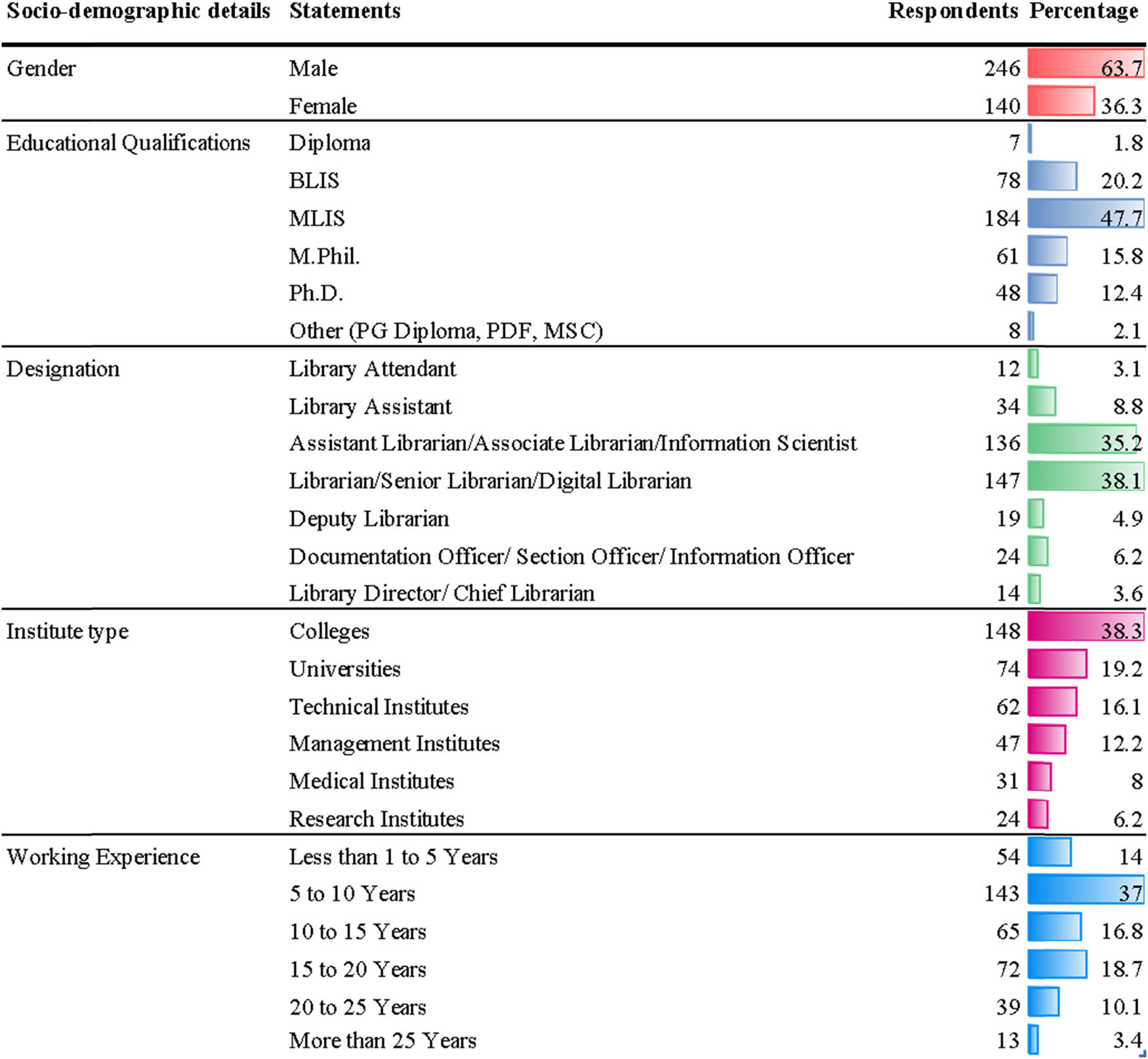 |
The analysis of Table 2 illustrates that library professionals widely recognise AI’s presence (98.7%) and willingness to train for its use (97.2%). Most support AI integration into services (89.9%) and its role in enhancing activities (90.9%), user accessibility (98.4%), and understanding user needs (95.9%). Many oppose AI replacing human intelligence (28.5%) and emphasise transparency (99%). They see AI as crucial (97.7%) but believe it will not replace librarians (71.5%), showcasing a positive outlook on AI’s potential and collaboration with human expertise. Figure 1 depicts the result in Table 2 more clearly.
Library Professionals’ Perspective on AI in Libraries
| Library Professionals’ Views on AI in Libraries | Yes (%) | No (%) |
|---|---|---|
| AI has been utilised in libraries | 98.7 | 1.3 |
| Willingness to receive training for using AI applications in library services | 97.2 | 2.8 |
| AI should be integrated into library services | 89.9 | 10.1 |
| AI replacing human intelligence in libraries | 28.5 | 71.5 |
| AI can enhance and improve library activities and services | 90.9 | 9.1 |
| AI would not replace librarians but will support them in performing advanced tasks | 90.2 | 9.8 |
| AI is a crucial technology libraries cannot disregard | 97.7 | 2.3 |
| AI’s potential to enhance accessibility and inclusivity of library services | 98.4 | 1.6 |
| AI applications to be transparent, explainable, and accountable in libraries | 99 | 1 |
| AI’s potential to assist libraries in comprehending and fulfilling user needs | 95.9 | 4.1 |
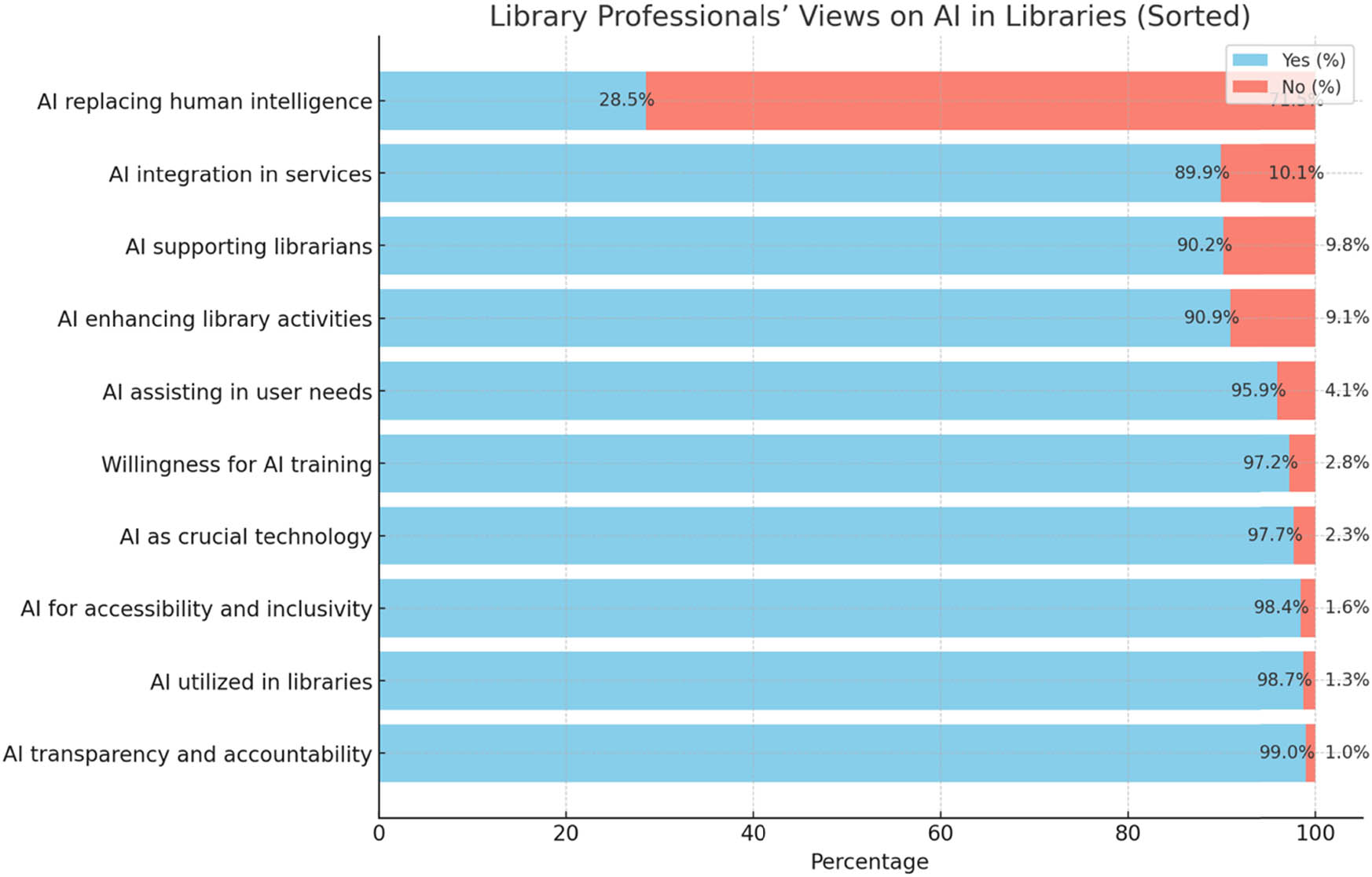
Library Professionals’ View on AI in Libraries.
Table 3 provides a skill-based analysis (rated from expert to beginner) of AI implementation impact in libraries. Notably, communication and collaboration (mean = 3.41), programming (mean = 1.92), information literacy and research skills (mean = 2.51), project management abilities (mean = 2.45), user experience (UX) design proficiency (mean = 2.07), ethical considerations (Mean = 1.47), and adaptability (mean = 2.27) significantly influence AI success (p < 0.00001). Conversely, understanding machine learning and deep learning algorithms, data analysis, and data management skills had a limited impact. While information architecture displayed some significance (p = 0.096354), it had a relatively minor effect. This analysis underscores the pivotal role of communication, technical proficiency, ethical awareness, and adaptability in realising effective AI integration in library settings. Figure 2 shows the result data trends from Table 3 in detail.
Impact of skills on AI implementation in Libraries: an analytical overview
| Relevance of Skills for AI Implementation in Library Settings | Mean | SD | T Value | p Value | Sign. |
|---|---|---|---|---|---|
| Understanding of machine learning and deep learning algorithm | 1.36 | 0.98 | 0 | 1 | No |
| Data analysis and data management skills | 1.45 | 1.04 | −1.56 | 0.11982 | |
| Information architecture | 1.28 | 0.88 | 1.66 | 0.096354 | |
| Communication and collaboration skills | 3.41 | 1.11 | −30.21 | <0.00001 | Yes |
| Programming skills | 1.92 | 1.09 | −9.5 | ||
| Information literacy and research skills | 2.51 | 1.24 | −17 | ||
| Project management skills | 2.45 | 1.12 | −15.68 | ||
| User experience (UX) design | 2.07 | 1.05 | −11.48 | ||
| Ethical considerations | 1.47 | 0.92 | −2.16 | 0.030704 | |
| Flexibility and adaptability | 2.27 | 1.10 | −13.55 | <0.00001 |
Note: SD: Standard Deviation; Sign. Significance.
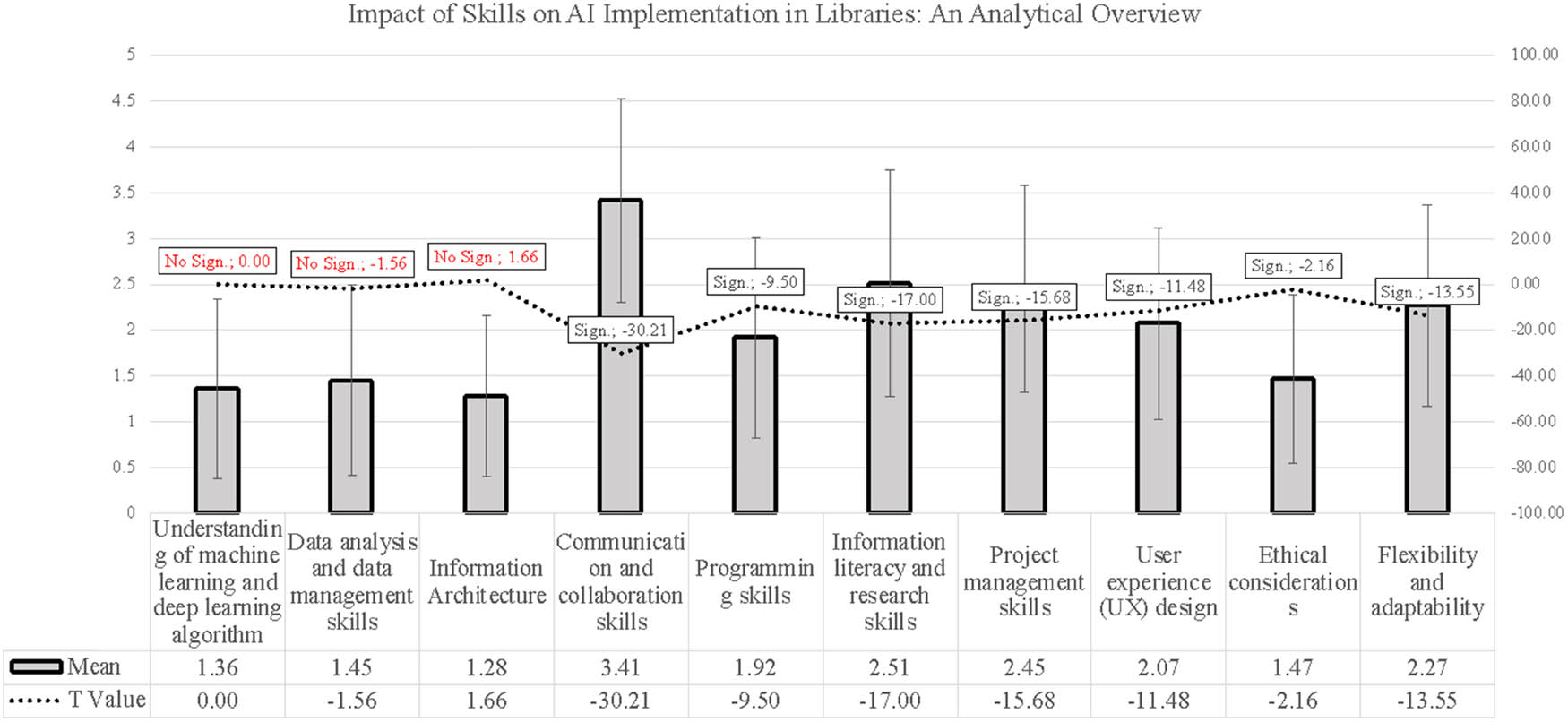
Impact of Skills on AI Implementation in Libraries.
Table 4 outlines perspectives on AI’s support for libraries, rated from strongly disagree (1) to strongly agree (5). Findings indicate strong agreement on AI’s potential to enhance search capabilities (mean = 4.04), accessibility (mean = 4.03), user experience (mean = 4.22), decision-making (mean = 3.96), efficiencies (mean = 3.67), discovery and access (mean = 3.80), research (mean = 3.41), cost savings (mean = 3.34), and resource preservation (mean = 3.46), all with p < 0.00001. Respondents foresee AI significantly benefiting various aspects of library functions, including information retrieval, inclusivity, user engagement, decision support, efficiency, and resource management. Figure 3 represents the result data trends from Table 4 in detail.
Which way will AI support the library? (Perspectives)
| AI will support the library in the following ways | Mean | SD | T Value | p Value | Sign. |
|---|---|---|---|---|---|
| It will improve search capabilities | 4.04 | 1.02 | −45.54 | <0.00001 | Yes |
| It will improve accessibility | 4.03 | 0.97 | −49.1 | ||
| It will improve the user experience | 4.22 | 0.98 | −51.55 | ||
| It will improve decision-making | 3.96 | 0.88 | −50.62 | ||
| Enhanced user experience | 3.41 | 1.1 | −30.86 | ||
| Increased efficiencies | 3.67 | 1.01 | −39.78 | ||
| Enhanced discovery and access | 3.80 | 1 | −42.84 | ||
| Enhanced research | 3.41 | 1.09 | −31.26 | ||
| Cost savings | 3.34 | 1.06 | −31.35 | ||
| Preservation and conservation of resources | 3.46 | 1.05 | −33.73 |
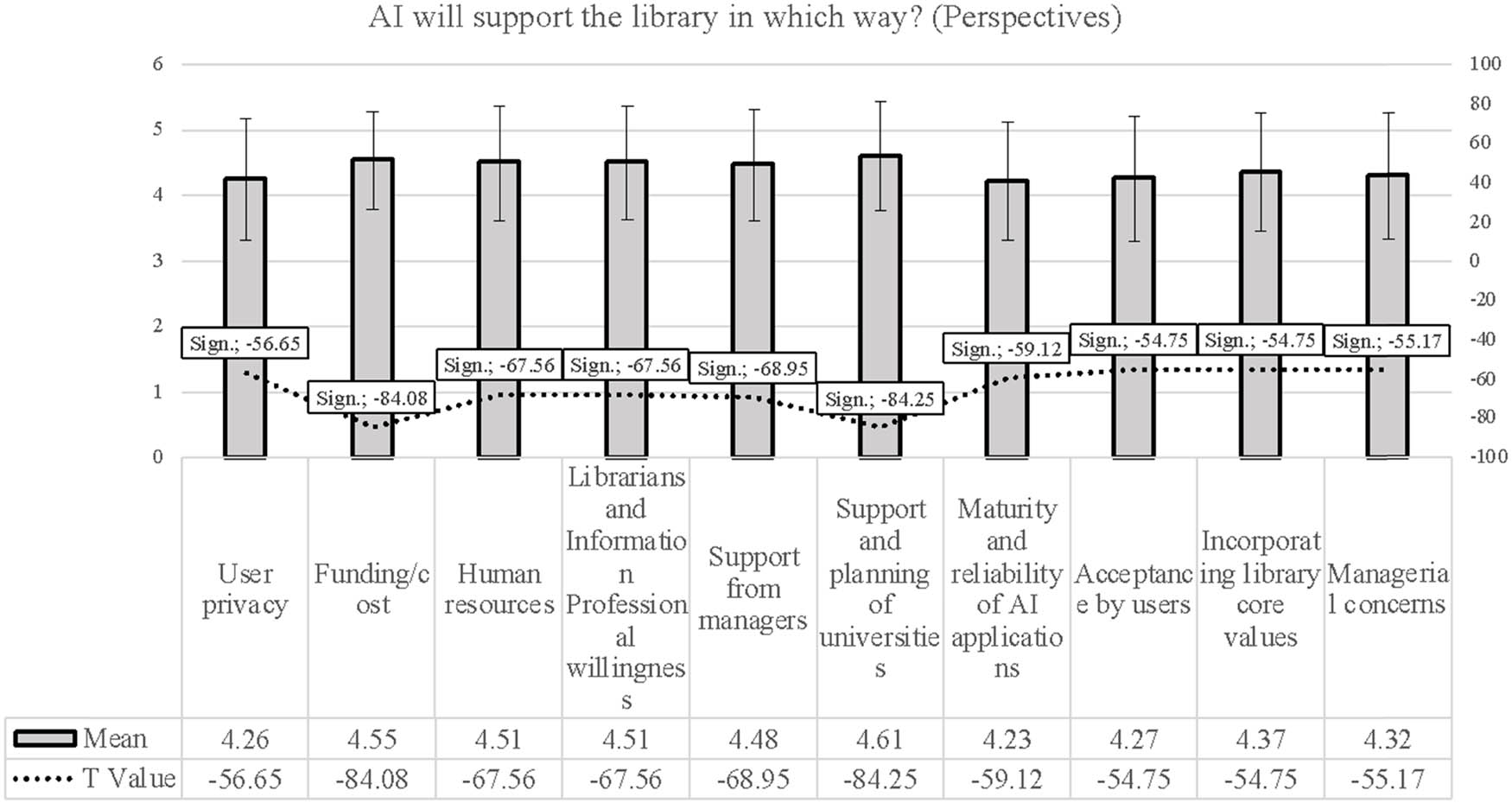
Which way will AI support the library? (Perspectives).
Table 5 presents vital factors (rated from strongly disagree to strongly agree) influencing AI integration in libraries. The findings emphasise the significance of various considerations: Strong agreement on user privacy (mean = 4.26), funding/cost (Mean = 4.55), human resources (mean = 4.51), librarian willingness (mean = 4.51), managerial support (mean = 4.48), university backing (mean = 4.61), AI application maturity and reliability (mean = 4.23), user acceptance (mean = 4.27), incorporation of library values (mean = 4.37), and managerial concerns (mean = 4.32), all with p < 0.00001. These factors collectively shape successful AI integration. They underscore the need for financial feasibility, human capacity, ethical compliance, user-centricity, and organisational endorsement as pivotal drivers for effective AI adoption in library contexts. Figure 4 illustrates the result data trends from Table 5 in detail.
An essential consideration in the application of AI tools in libraries
| Factors Influencing AI Integration in Libraries | Mean | SD | T Value | p Value | Sign. |
|---|---|---|---|---|---|
| User privacy | 4.26 | 0.93 | −56.65 | <0.00001 | Yes |
| Funding/cost | 4.55 | 0.75 | −84.08 | ||
| Human resources | 4.51 | 0.88 | −67.56 | ||
| Librarians and Information Professional’s willingness | 4.51 | 0.87 | −67.56 | ||
| Support from managers | 4.48 | 0.86 | −68.95 | ||
| Support and planning of universities | 4.61 | 0.83 | −84.25 | ||
| Maturity and reliability of AI applications | 4.23 | 0.90 | −59.12 | ||
| Acceptance by users | 4.27 | 0.95 | −54.75 | ||
| Incorporating library core values | 4.37 | 0.90 | −54.75 | ||
| Managerial concerns | 4.32 | 0.96 | −55.17 |
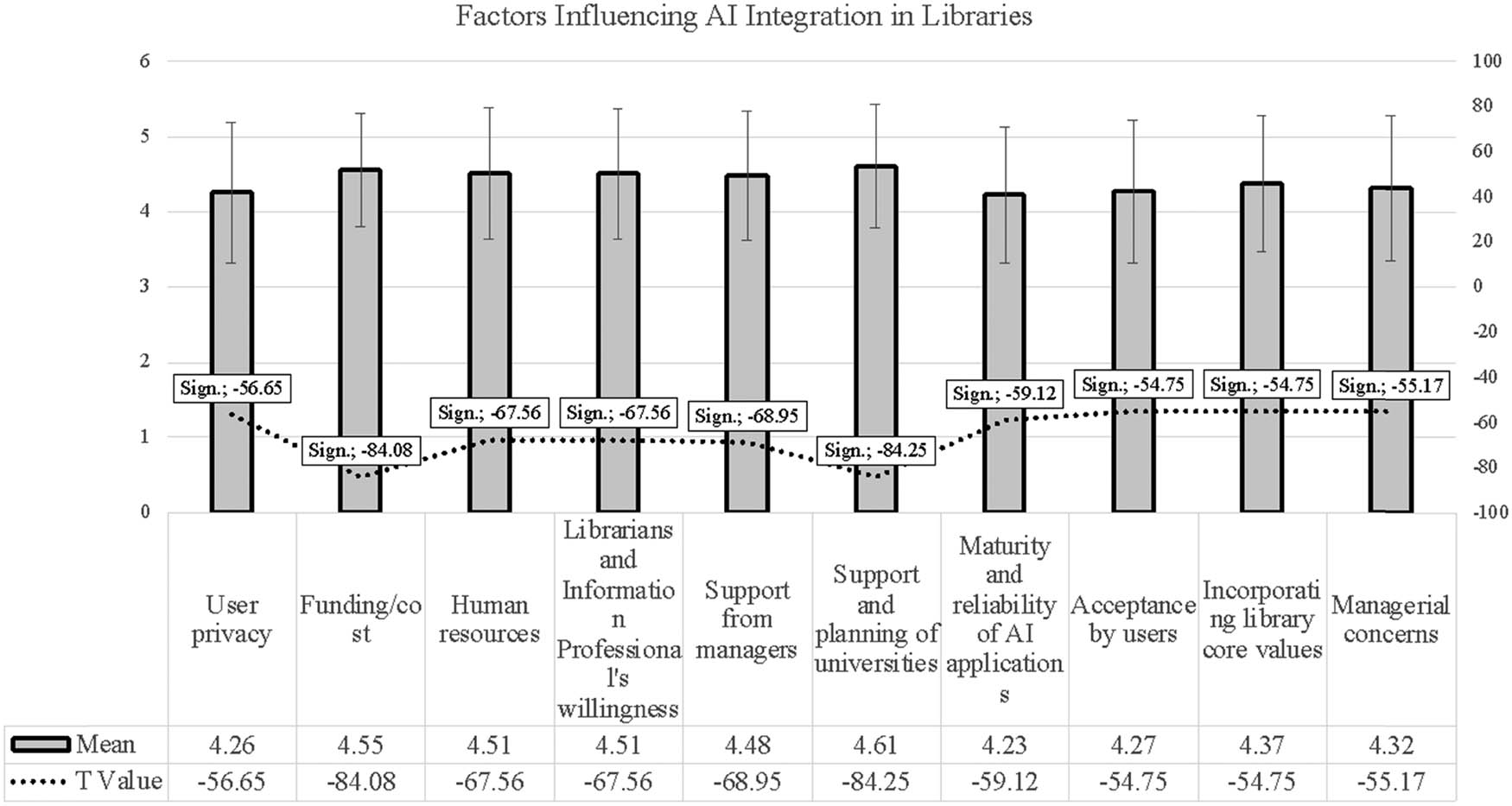
An essential consideration in the application of AI tools in libraries.
Table 6 shows AI tool adoption in institute libraries. The data reveal that 16.8% employ Chatbots, 12.7% use recommendation systems, and 23.6% utilise OCR. Smart shelving sees substantial adoption at 26.4%. Lesser-used tools include NLP (2.8%), text mining (3.6%), image recognition (7.5%), and speech recognition (11.4%). Knowledge graphs and automatic metadata generation are less common (1.8 and 16.1%, respectively). These findings illustrate the diversity in AI tool adoption across libraries, with OCR and smart shelving being more widely embraced.
AI tools and services adopted by your institute libraries (Multiple answers were allowed)
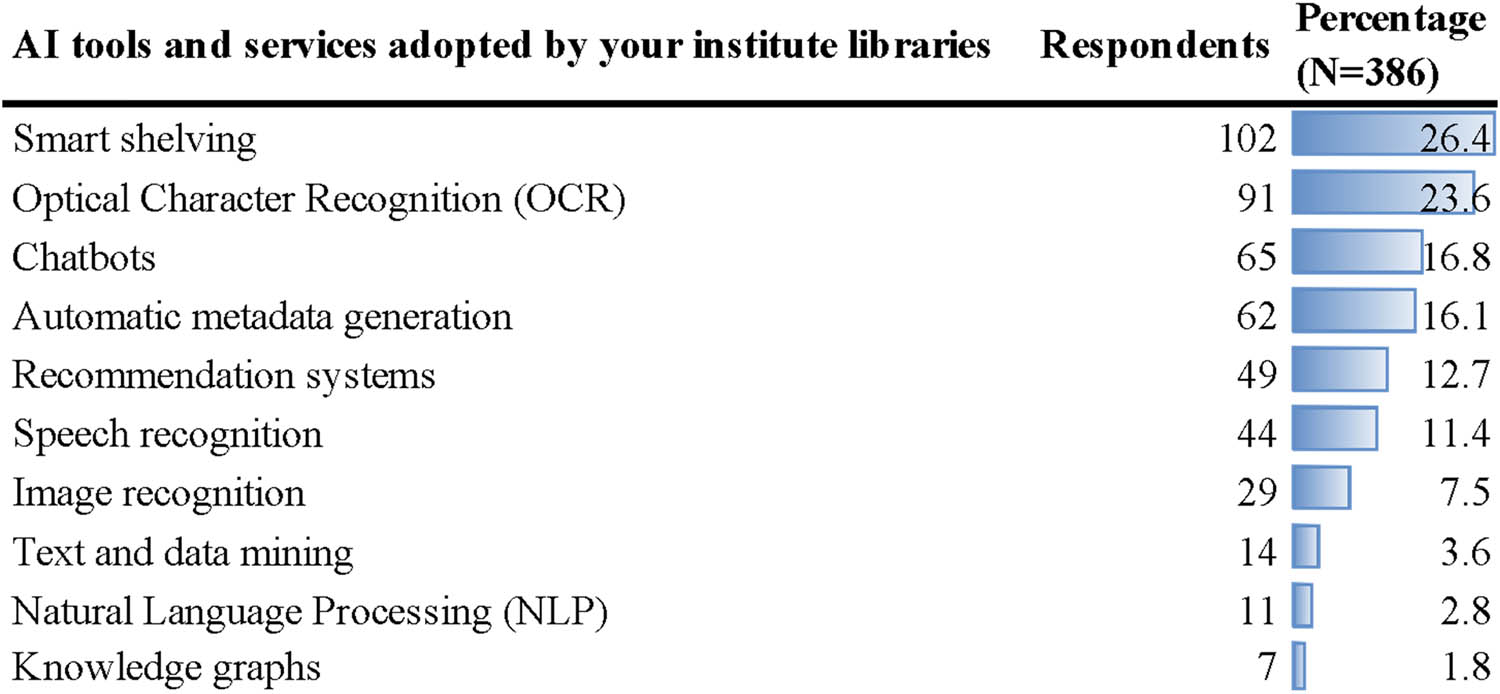 |
Table 7 presents the ethical facets of AI application on a ranked scale from very high concern to no concern. Findings underscore notable ethical considerations: The issue of bias and discrimination (mean = 4.40) garners strong consensus as a significant concern (p < 0.00001). Privacy and security (mean = 3.51), transparency and explainability (mean = 3.63), accountability (mean = 3.54), employment implications (mean = 3.85), and intellectual freedom (mean = 4.43) all emerge as significant ethical worries (p < 0.00001). These outcomes stress the widespread ethical apprehensions that accompany AI integration in libraries. They accentuate the need to address bias, privacy, transparency, accountability, employment effects, and intellectual freedom to use AI technologies responsibly. Figure 5 depicts the result data trends from Table 7 more clearly.
Exploring Ethical Dimensions of AI Utilisation
| Ethical Considerations in AI Utilisation | Mean | SD | T Value | p Value | Significance |
|---|---|---|---|---|---|
| Bias and discrimination | 4.40 | 0.91 | −61.48 | <0.00001 | Yes |
| Privacy and security | 3.51 | 1.1 | −32.23 | ||
| Transparency and explainability | 3.63 | 1.01 | −39.17 | ||
| Accountability | 3.54 | 1.06 | −34.74 | ||
| Employment | 3.85 | 1.08 | −38.24 | ||
| Intellectual freedom | 4.43 | 0.75 | −67.3 |
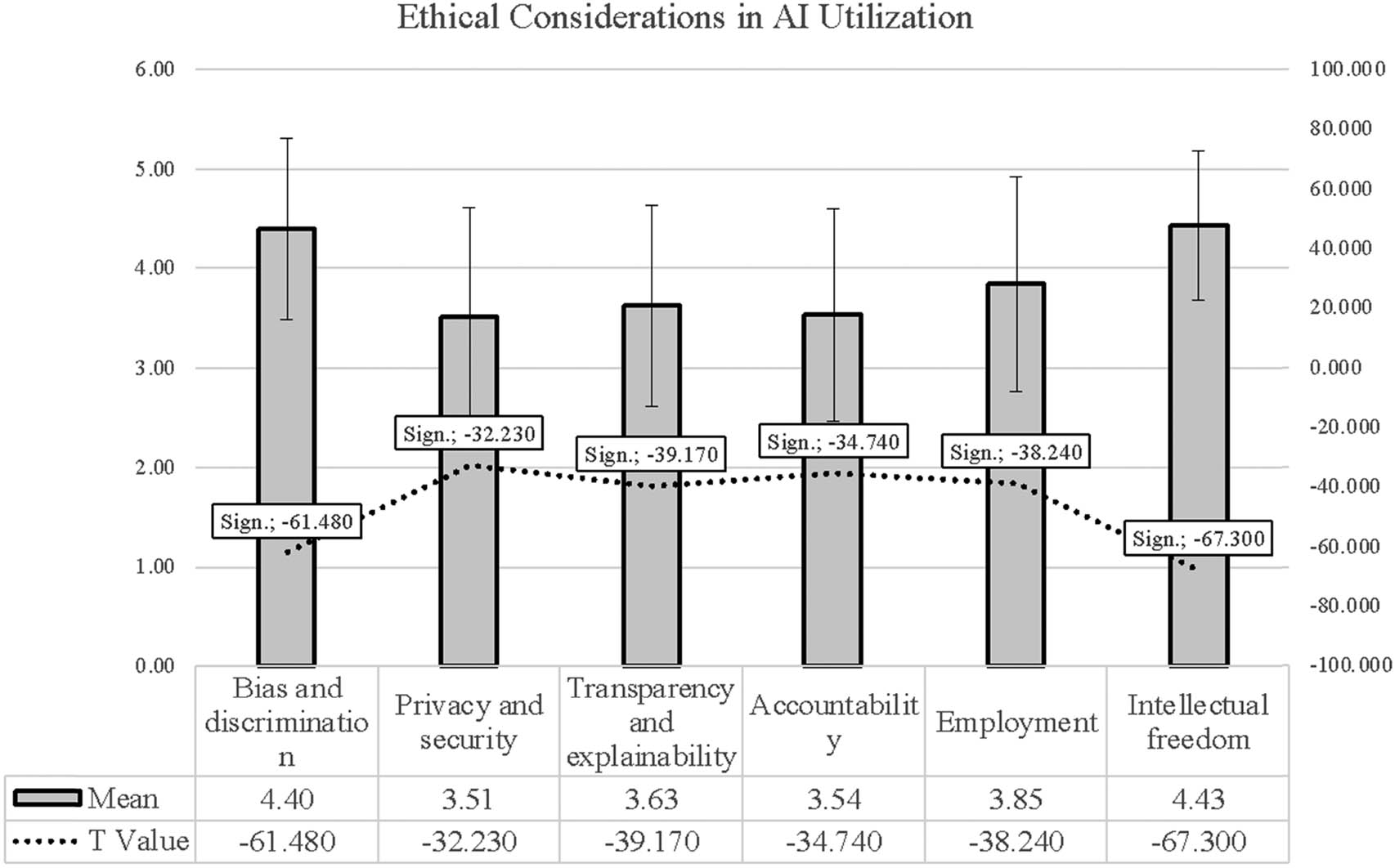
Exploring Ethical Dimensions of AI Utilisation.
5 Discussion
Table 1 presents an overview of the socio-demographic characteristics of library professionals in India. The findings show that the library profession in India is male dominated; Brown argues that using AI in libraries does not have many gender issues (Chen et al., 2021). For instance, chatbots have been given typically feminine names, appearances, voices, and even personalities, giving the impression of a future in which technology design will take a more feminist and gender-inclusive approach and move away from the patriarchal inclinations in designing digital assistants as women (Johnson, 2018).
Table 2 presents an overview of the perspective of Indian library professionals on AI usage in libraries. The increase in computer processing, big data, and machine learning techniques has given rise to AI developments in several library sectors (Bi et al., 2022). The respondents indicated that AI technologies were in use in library operations among libraries in India, and they believed that AI could not replace human intelligence in libraries despite AI integration (Harisanty et al., 2023). The respondents also indicated that AI made libraries more efficient, accessible, and transparent, in line with Harisanty et al.’s observation that AI technologies could easily be incorporated into libraries for administration functions, like staffing, technical functions cataloguing, and informational functions like reference and information literacy (Harisanty et al., 2023). From the results, it can be deduced that the respondents were aware that AI was already used in library operations to enhance routine and administrative tasks (Williams, 2019).
Table 3 presents an overview of the discrepancies in the perceived knowledge and proficiencies concerning AI technologies among Indian library professionals. According to Al-Aamri and Osman, many libraries integrate AI technologies into various services. This result supports the respondents’ responses that they were aware of AI and the skills related to AI technologies in the libraries (Al-Aamri & Osman, 2022). From the results, it is evident that despite the potential of AI in libraries, library professionals need the necessary technical and soft skills, emphasising that library professionals must be proficient in AI, including an understanding of AI technologies and tools, data analytics, library management, user behaviour, and system architecture (Wood & Evans, 2018). According to Gul and Bano, in handling smart technologies, library professionals have to be knowledgeable about smart library technologies. Therefore, modern library professionals must be IT proficient; have strong knowledge of data analytics, library management, and user behaviour; and be adaptable and creative (Gul & Bano, 2019).
Table 4 presents an overview of the potential usage of AI in libraries. AI is a powerful technology that can improve library services, resulting in positive transformation and hastening library growth (Chen et al., 2021). Libraries are already integrating AI technologies in various services, such as technical support and reference services, to facilitate users’ access to information (Arlitsch & Newell, 2017). In this study, the respondents strongly believed that AI would improve decision-making, user experience, search capabilities, and accessibility to enhance discovery and access and increase efficiencies (Harisanty et al., 2023). There are disagreements and concerns regarding the perspectives on enhanced user experience, enhanced research, and AI adoption’s cost and resource implications. The perspectives on cost savings and preservation and conservation of resources are also not strongly agreed upon (Hussain, 2023).
Table 5 presents an overview of Indian library professionals’ perceptions regarding the impact of AI technologies on library resources and services. The respondents believed that several essential factors must be considered when implementing AI applications in libraries (Yoon et al., 2021). According to the respondents, user privacy, funding/cost, human resources, librarian and information professional willingness, support from managers, support and planning of universities, and incorporating library core values are all critical factors to consider (Weijia, 2022). The participants recognise the importance of considering various factors when implementing AI applications in libraries, ranging from user privacy and security concerns to ensuring alignment with the library’s core values and strategic goals (Cox, 2022). Adequate funding, staffing, and support from managers and universities are essential for successfully implementing and maintaining library AI applications (Bradley, 2022). According to earlier studies, there needs to be more funds for acquiring AI technologies and employing librarians with the necessary skills to work with the technology, as well as infrastructural and technical talent issues and management problems (Ali, Naeem, Bhatti, & Richardson, 2022).
Table 6 presents an overview of AI tools and services currently used within Indian libraries. The respondents believed various AI tools and services must be used to implement smart libraries (Bi et al., 2022). According to the respondents, the most adopted tool is smart shelving, which uses RFID and other tracking technologies in conjunction with AI algorithms to automatically track the location and movement of library resources field (Chen et al., 2021). The respondents also indicated that other adopted tools, including OCR, automatic metadata generation, recommendation systems, speech recognition, and image recognition with NLP and knowledge graphs, were less commonly adopted (Bi et al., 2022).
Table 7 presents an overview of ethical considerations on AI utilisation among library professionals. Most respondents were concerned with AI bias and intellectual freedom in using AI in libraries. Other concerns included privacy and security, transparency, accountability, and employment (Cox, 2022). According to earlier studies, AI technology should prioritise serving humanity as the highest goal, consider human nature, and regulate AI human rights ethics (Miao, 2019).
6 Limitations of the Study
While the research offers valuable insights into the perceptions and readiness of Indian library professionals regarding AI integration, certain limitations need acknowledgement:
The study predominantly focused on library professionals within academic institutions. Extending the survey to encompass a wider range of libraries, such as public or special libraries, could provide a more comprehensive understanding of AI perceptions across diverse library settings.
The research primarily concentrated on Indian libraries, potentially limiting the generalisability of findings to libraries in other geographical locations. Comparative studies across various regions or international collaborations could offer broader perspectives.
The reliance on a closed-ended survey might have constrained the depth of responses. Qualitative methodologies, such as interviews or focus group discussions, could offer richer insights into nuanced opinions and experiences regarding AI in libraries.
7 Future Research Directions
Conducting longitudinal studies to track the evolving attitudes and adoption of AI in libraries over time could provide a more dynamic understanding of its integration and the changing perspectives of library professionals. Comparing the adoption and perceptions of AI in libraries across different countries or regions could facilitate cross-cultural insights, identifying contextual factors influencing AI implementation in diverse settings.
Augmenting the quantitative approach with qualitative methods, such as in-depth interviews or case studies, can unveil nuanced perspectives and delve deeper into AI integration’s challenges and success stories in libraries. Evaluating the actual impact of implemented AI tools and services on library operations, user experiences, and resource utilisation would provide empirical evidence supporting the perceived benefits and addressing concerns. Developing comprehensive ethical frameworks tailored specifically for AI implementation in library services could guide practitioners in navigating ethical dilemmas effectively.
8 Conclusion
Based on the survey results, it is evident that library professionals in India have a strong awareness of AI technologies and their potential applications in libraries. Most library professionals hold MLIS degrees and occupy librarian, senior, and digital librarian positions in colleges and universities. This result indicates a mature profession capable of understanding and adopting trending technologies like AI.
The findings also indicate that AI technologies are already being used in library operations in India, with respondents acknowledging the benefits of AI in improving efficiency, accessibility, and transparency in library services. Furthermore, there is a consensus among respondents that AI cannot replace human intelligence in libraries. Library professionals recognise the importance of acquiring the necessary technical and soft skills related to AI, including data analytics, library management, and user behaviour analysis.
The survey highlights the potential of AI to enhance decision-making, user experience, search capabilities, and library accessibility. There are differing opinions and concerns regarding the cost implications, resource requirements, and preservation of resources associated with AI adoption. Ethical concerns such as bias and discrimination, intellectual freedom, transparency, and accountability are essential considerations in using AI in library services.
-
Funding information: This research did not receive any specific grant from funding agencies in the public, commercial, or not-for-profit sectors.
-
Author contributions: Subaveerapandiyan A: Contribution: Conceptualization, Methodology, Validation, Formal analysis, Investigation, Writing – Original Draft; Alfian Akbar Gozali. Contribution: Writing – Review & Editing, Visualization, Validation, Formal analysis, Data Curation.
-
Conflict of interest: Authors state no conflict of interest.
References
Abayomi, O. K., Adenekan, F. N., Abayomi, A. O., Ajayi, T. A., & Aderonke, A. O. (2020). Awareness and perception of the artificial intelligence in the management of university libraries in Nigeria. Journal of Interlibrary Loan, Document Delivery & Electronic Reserve, 29(1–2), 13–28. doi: 10.1080/1072303X.2021.1918602.Search in Google Scholar
Ajani, Y. A., Tella, A., Salawu, K. Y., & Abdullahi, F. (2022). Perspectives of librarians on awareness and readiness of academic libraries to integrate artificial intelligence for library operations and services in Nigeria. Internet Reference Services Quarterly, 26(4), 213–230. doi: 10.1080/10875301.2022.2086196.Search in Google Scholar
Al-Aamri, J. H., & Osman, N. E. (2022). The role of artificial intelligence abilities in library services. The International Arab Journal of Information Technology, 19(3A), 566–573. doi: 10.34028/iajit/19/3A/16.Search in Google Scholar
Ali, M. Y., Naeem, S. B., Bhatti, R., & Richardson, J. (2022). Artificial intelligence application in university libraries of Pakistan: SWOT analysis and implications. Global Knowledge, Memory and Communication, 73(1/2), 219–234. doi: 10.1108/GKMC-12-2021-0203.Search in Google Scholar
Arlitsch, K., & Newell, B. (2017). Thriving in the age of accelerations: A brief look at the societal effects of artificial intelligence and the opportunities for libraries. Journal of Library Administration, 57(7), 789–798. doi: 10.1080/01930826.2017.1362912.Search in Google Scholar
Bi, S., Wang, C., Zhang, J., Huang, W., Wu, B., Gong, Y., & Ni, W. (2022). A survey on artificial intelligence aided internet-of-things technologies in emerging smart libraries. Sensors, 22(8), 2991. doi: 10.3390/s22082991.Search in Google Scholar
Bradley, F. (2022). Representation of libraries in artificial intelligence regulations and implications for ethics and practice. Journal of the Australian Library and Information Association, 71(3), 189–200. doi: 10.1080/24750158.2022.2101911.Search in Google Scholar
Chen, Z., Zhou, M., & Feng, L. (2021). Analysis of the smart library construction in colleges based big data and artificial intelligence. Journal of Physics: Conference Series, 1955(1), 012017. doi: 10.1088/1742-6596/1955/1/012017.Search in Google Scholar
Cox, A. (2022). The ethics of AI for information professionals: Eight scenarios. Journal of the Australian Library and Information Association, 71(3), 201–214. doi: 10.1080/24750158.2022.2084885.Search in Google Scholar
Gul, S., & Bano, S. (2019). Smart libraries: An emerging and innovative technological habitat of 21st century. The Electronic Library, 37(5), 764–783. doi: 10.1108/EL-02-2019-0052.Search in Google Scholar
Harisanty, D., Anna, N. E. V., Putri, T. E., Firdaus, A. A., & Noor Azizi, N. A. (2022). Leaders, practitioners and scientists’ awareness of artificial intelligence in libraries: A pilot study. Library Hi Tech (ahead-of-print). doi: 10.1108/LHT-10-2021-0356.Search in Google Scholar
Harisanty, D., Anna, N. E. V., Putri, T. E., Firdaus, A. A., & Noor Azizi, N. A. (2023). Is adopting artificial intelligence in libraries urgency or a buzzword? A systematic literature review. Journal of Information Science, 01655515221141034. doi: 10.1177/01655515221141034.Search in Google Scholar
Huang, Y. H. (2022). Exploring the implementation of artificial intelligence applications among academic libraries in Taiwan. Library Hi Tech (ahead-of-print). doi: 10.1108/LHT-03-2022-0159.Search in Google Scholar
Hussain, A. (2023). Use of artificial intelligence in the library services: Prospects and challenges. Library Hi Tech News, 40(2), 15–17. doi: 10.1108/LHTN-11-2022-0125.Search in Google Scholar
Johnson, B. (2018). Libraries in the age of artificial intelligence. Computers in Libraries, 38(1), 14–16.Search in Google Scholar
Miao, Z. (2019). Investigation on Human Rights Ethics in Artificial Intelligence Researches with Library Literature Analysis Method’. The Electronic Library, 37(5), 914–926. doi: 10.1108/EL-04-2019-0089.Search in Google Scholar
Talley, N. B. (2016). Imagining the use of intelligent agents and artificial intelligence in academic law libraries. Law Library Journal, 108, 383.Search in Google Scholar
Weijia, G. (2022). Influencing factors of artificial intelligence readiness in libraries. Journal of Agricultural Library and Information Science, 34(5), 47–56. doi: 10.13998/j.cnki.issn1002-1248.22-0016.Search in Google Scholar
Williams, R. (2019). Artificial intelligence assistants in the library: Siri, Alexa, and beyond. Online Searcher, 43(3), 10–14.Search in Google Scholar
Wood, B. A., & Evans, D. (2018). Librarians’ perceptions of artificial intelligence and its potential impact on the profession. Computers in Libraries, 38(1).Search in Google Scholar
Yoon, J., James E. A., & Heather L. W. (2021). Perceptions on adopting artificial intelligence and related technologies in libraries: Public and academic librarians in North America. Library Hi Tech, 40(6), 1893–1915. doi: 10.1108/LHT-07-2021-0229.Search in Google Scholar
© 2024 the author(s), published by De Gruyter
This work is licensed under the Creative Commons Attribution 4.0 International License.
Articles in the same Issue
- Regular Articles
- FSLSM-Based Analysis of Student Performance Information in a Blended Learning Course Using Moodle LMS
- AI in Indian Libraries: Prospects and Perceptions from Library Professionals
- Comprehensive Examination of Version Number Attacks in IoT Networks: Nodes Hyperactivity as Specific Criterion
- AI Literacy and Zambian Librarians: A Study of Perceptions and Applications
- Awareness and Perception of Students Toward Execution of Internet of Things in Library Services: A study of Indian Institute Technologies of Northern India
- Hybrid RSA–AES-Based Software-Defined Network to Improve the Security of MANET
- Enhanced Image-Based Malware Multiclass Classification Method with the Ensemble Model and SVM
- A Qualitative Analysis of Open-Access Publishing-Related Posts on Twitter
- Exploring the Integration of Artificial Intelligence in Academic Libraries: A Study on Librarians’ Perspectives in India
- “Librarying” Under the Candlelight: The Impact of Electricity Power Outages on Library Services
- Management of Open Education Resources in Academic Libraries of Nigerian Public Universities
- The Evolution of Job Displacement in the Age of AI and Automation: A Bibliometric Review (1984–2024)
- Review Article
- Open Network for Digital Commerce in India: Past, Present, and Future
- Communications
- Publishing Embargoes and Versions of Preprints: Impact on the Dissemination of Information
- The Detection of ChatGPT’s Textual Crumb Trails is an Unsustainable Solution to Imperfect Detection Methods
Articles in the same Issue
- Regular Articles
- FSLSM-Based Analysis of Student Performance Information in a Blended Learning Course Using Moodle LMS
- AI in Indian Libraries: Prospects and Perceptions from Library Professionals
- Comprehensive Examination of Version Number Attacks in IoT Networks: Nodes Hyperactivity as Specific Criterion
- AI Literacy and Zambian Librarians: A Study of Perceptions and Applications
- Awareness and Perception of Students Toward Execution of Internet of Things in Library Services: A study of Indian Institute Technologies of Northern India
- Hybrid RSA–AES-Based Software-Defined Network to Improve the Security of MANET
- Enhanced Image-Based Malware Multiclass Classification Method with the Ensemble Model and SVM
- A Qualitative Analysis of Open-Access Publishing-Related Posts on Twitter
- Exploring the Integration of Artificial Intelligence in Academic Libraries: A Study on Librarians’ Perspectives in India
- “Librarying” Under the Candlelight: The Impact of Electricity Power Outages on Library Services
- Management of Open Education Resources in Academic Libraries of Nigerian Public Universities
- The Evolution of Job Displacement in the Age of AI and Automation: A Bibliometric Review (1984–2024)
- Review Article
- Open Network for Digital Commerce in India: Past, Present, and Future
- Communications
- Publishing Embargoes and Versions of Preprints: Impact on the Dissemination of Information
- The Detection of ChatGPT’s Textual Crumb Trails is an Unsustainable Solution to Imperfect Detection Methods

